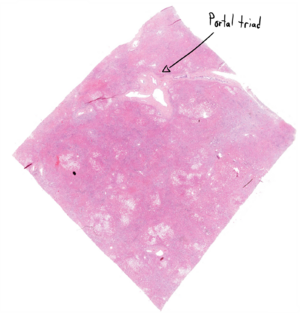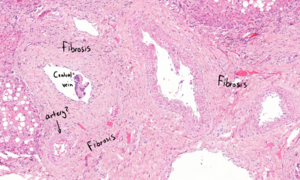8. Alcoholic hepatitis: Difference between revisions
(Created page with "''As of spring 2020 this topic is not part of the curriculum, so you shouldn’t have to learn it.'' '''Staining''': HE '''Organ''': Liver '''Description''': There are five characteristics that can be seen: # Some hepatocytes are swollen with very pale cytoplasm. This is called ballooning degeneration # Some hepatocytes have no nuclei. This indicates necrosis # Some hepatocytes have bright eosinophilic inclusion bodies called Mallory bodies # Fibrosis is visible # N...") |
(No difference)
|
Revision as of 09:48, 16 June 2022
As of spring 2020 this topic is not part of the curriculum, so you shouldn’t have to learn it.
Staining: HE
Organ: Liver
Description:
There are five characteristics that can be seen:
- Some hepatocytes are swollen with very pale cytoplasm. This is called ballooning degeneration
- Some hepatocytes have no nuclei. This indicates necrosis
- Some hepatocytes have bright eosinophilic inclusion bodies called Mallory bodies
- Fibrosis is visible
- Neutrophils are present
Diagnosis: Alcoholic hepatitis
Causes:
- Chronic (years of) alcohol consumption
Theory:
These five histological findings are the five histological criteria that must be fulfilled to say that it is an alcoholic hepatitis.
This patient would probably also have an AST/ALT ratio of above 2:1, and possibly macrocytic anaemia as well.
All the characteristics are visible around the big portal triad, so I’d suggest you start looking there.





